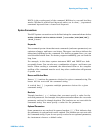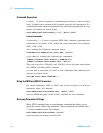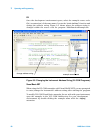Operating and Programming 3
L4400 User’s Guide 53
ROUTe is the root keyword of the command, MONitor is a second- level key-
words, CHANnel is a third- level keyword, and so on. A colon ( : ) separates a
command keyword from a lower- level keyword.
Syntax Conventions
The SCPI syntax convention can be defined using the command shown below:
ROUTe:CHANnel:DRIVe:PULSe:WIDTh {<seconds>|MIN|MAX|DEF},
(@<ch_list>)
Keywords
The command syntax shows that most commands (and some parameters) are
a mixture of upper- and lower-case letters. The upper-case letters indicate the
abbreviated spelling for the command. For shorter program lines, you can
send the abbreviated form. For better program readability, you can send the
long form.
For example, in the above syntax statement DRIV and DRIVE are both
acceptable forms. You can also use a combination of upper- and lower-case
letters. When sending a command, the abbreviated form or the complete
spelling of the command must be used. Any other combination will generate
a syntax error.
Braces and Vertical Bars
Braces ( { } ) enclose the parameter choices for a given command string. The
braces are not sent with the command string.
A vertical bar ( | ) separates multiple parameter choices for a given
command string.
Brackets
Triangle brackets ( < > ) indicate that you must specify a value for the
enclosed parameter. For example, the syntax statement shows the <seconds>
parameter enclosed in triangle brackets. The brackets are not sent with the
command string. You must specify a value for the parameter.
Optional Parameters
Some parameters are enclosed in square brackets ( [ ] ). This indicates that
the parameter is optional and can be omitted. The brackets are not sent with
the command string. If you do not specify a value for an optional parameter,
the instrument chooses a default value.


















